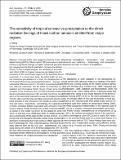The sensitivity of tropical convective precipitation to the direct radiative forcings of black carbon aerosols emitted from major regions
Author(s)
Wang, Chien
DownloadWang-2009-The sensitivity of tropical convective precipitation to the direct radiative forcings of black carbon aerosols.pdf (11.11Mb)
PUBLISHER_CC
Publisher with Creative Commons License
Creative Commons Attribution
Terms of use
Metadata
Show full item recordAbstract
Previous works have suggested that the direct radiative forcing (DRF) of black carbon (BC) aerosols are able to force a significant change in tropical convective precipitation ranging from the Pacific and Indian Ocean to the Atlantic Ocean. In this in-depth analysis, the sensitivity of this modeled effect of BC on tropical convective precipitation to the emissions of BC from 5 major regions of the world has been examined. In a zonal mean base, the effect of BC on tropical convective precipitation is a result of a displacement of ITCZ toward the forcing (warming) hemisphere. However, a substantial difference exists in this effect associated with BC over different continents. The BC effect on convective precipitation over the tropical Pacific Ocean is found to be most sensitive to the emissions from Central and North America due to a persistent presence of BC aerosols from these two regions in the lowermost troposphere over the Eastern Pacific. The BC effect over the tropical Indian and Atlantic Ocean is most sensitive to the emissions from South as well as East Asia and Africa, respectively. Interestingly, the summation of these individual effects associated with emissions from various regions mostly exceeds their actual combined effect as shown in the model run driven by the global BC emissions, so that they must offset each other in certain locations and a nonlinearity of this type of effect is thus defined. It is known that anthropogenic aerosols contain many scattering-dominant constituents that might exert an effect opposite to that of absorbing BC. The combined aerosol forcing is thus likely differing from the BC-only one. Nevertheless, this study along with others of its kind that isolates the DRF of BC from other forcings provides an insight of the potentially important climate response to anthropogenic forcings particularly related to the unique particulate solar absorption.
Date issued
2009-10Department
Massachusetts Institute of Technology. Center for Global Change Science; Massachusetts Institute of Technology. Joint Program on the Science & Policy of Global ChangeJournal
Annales Geophysicae
Publisher
Copernicus Publications on behalf of the European Geosciences Union
Citation
Wang, C. "The sensitivity of tropical convective precipitation to the direct radiative forcings of black carbon aerosols emitted from major regions.", Annales geophysicae, 27, (2009) 3705-3711.
Version: Final published version
ISSN
1432-0576
0992-7689